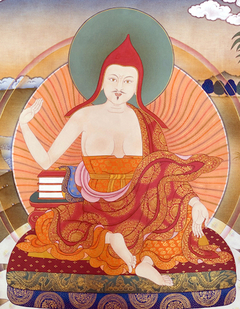Madhyamakāvatāra Prologue
Prologue to Introduction to the Middle Way (Madhyamakāvatāra)
by Khenpo Shenpen Nangwa
As regards the Middle Way treatises, the Root Verses on Wisdom (Mūlamadhyamaka-kārikā) is primary; it is like the progenitor of all the other works in the Collection of Reasoning. There is no need to question whether or not the other texts are Middle Way treatises.
How does this text provide an introduction to this? The [Madhyamakāvatāra]bhāṣya says: “The Middle Way treatise describes the nature of the relative and ultimate in elaborate detail. Since this is taught elaborately here in the Introduction to the Middle Way, this treatise serves as an introduction to it.” As this states, it provides an introduction by teaching the nature of the relative and ultimate extensively.
The treatise [i.e., Mūlamadhyamaka-kārikā] includes the following:
The teachings taught by the buddhas
Entirely depend on the two truths:
The relative truth of the world and
The truth of the ultimate meaning.[1]
And:
Without relying on the conventional,
The ultimate meaning will not be realized,
And if one does not realize the ultimate,
One will not attain nirvāṇa.[2]
Such passages do describe the two truths, but the presentation of relative truth does not seem detailed to those of us with inferior minds.
This work however introduces the ten transcendent perfections and eleven bhūmis on the basis of relative truth and, on the basis of the ultimate truth, explains how there is no arising even conventionally according to the four extremes. Thus, this commentary on the intent of the Middle Way includes several uncommon features not found in the works of other scholars.
Therefore, the wisdom of omniscience is also described in this text as being the result of correctly realising the two truths:
With the white wings of the relative and ultimate extended,
The king of swans flies ahead of ordinary, lesser birds,
And through the strength of the forceful wind of virtue
Reaches the supreme, distant shore of the sea of buddha’s qualities.[3]
And, from the opposite perspective:
Aside from honourable Nāgārjuna’s way,
There is no means of reaching peace.
Others mistake the relative and ultimate truths,
And with this failure there can be no liberation.[4]
Another category is introduction by means of both the profound and the vast. The text itself says:
The profound is emptiness,
And other qualities are vast.
It is by knowing the profound and vast
That these qualities are attained.[5]
And:
Those who master the modes of profound and vast
Will gradually attain the bhūmi of Perfect Joy,
So whoever aspires to this should listen well.[6]
In terms of the profound, the text also teaches the twenty emptinesses and the process of dependently imputing individuals and so on through the sevenfold reasoning of the chariot. Concerning the vast, there is an elaborate presentation of the ten transcendent perfections in this text. For this reason, it is also said to “clarify the ways of the profound and the vast.”[7]
Thus, when explaining this treatise that correctly resolves the key points of the Middle Way Treatise,[8] the Introduction to the Middle Way together with its autocommentary, we must begin with the meaning of the title…
| Translated by Adam Pearcey, 2020.
Bibliography
Tibetan Edition
gzhan phan chos kyi snang ba. "dbu ma la 'jug pa'i 'chad thabs". In gzhung chen bcu gsum. 7 vols. Delhi: Konchhog Lhadrepa, 1983, 1993. (BDRC W23198). Vol. 5: 147–149.
Secondary Sources
Padmakara Translation Group. Introduction to the Middle Way: Chandrakirti's Madhyamakavatara with commentary by Jamgön Mipham. Boston, MA: Shambhala, 2004.
Version: 1.2-20220112
